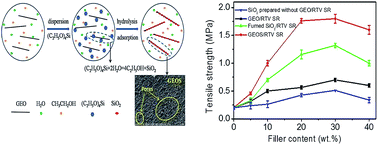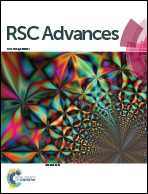Design of a nanoporous interfacial SiO2 layer in polysiloxane–graphene oxide nanocomposites for efficient stress transmission†
Abstract
Interfacial interaction between graphene oxide (GEO) sheets and polysiloxane is important for the applications of GEO based silicone systems. However, polysiloxane is a polymer that suffers from poor affinity with graphene oxide, which has become a bottleneck for the integration and applications of GEO in such polymer matrixes. Here we introduce an effective approach to solve the problem by employing SiO2 as an interfacial layer. Being compatible with both GEO and silicone, the interfacial layer is nanoporous and tunable. Firstly, GEO was modified with nanoporous SiO2 via a sol–gel process. Secondly, GEO/SiO2 (GEOS) was integrated into a fluid-like hydroxyl terminated polydimethylsiloxane (PDMS-OH) through a solvent-free blending process. Thirdly, the GEOS/PDMS-OH matrix was vulcanized at room temperature (RTV), forming the final silicon rubber (SR) elastomer. A tensile strength of 3.36 MPa and a Young's modulus of 3.38 MPa were achieved for the RTV SR elastomer, higher than those of GEO (0.69 and 1.40 MPa) and fumed SiO2 (1.32 and 2.2 MPa) based ones at the same filling fractions. The strong interactions between SiO2 and GEO, as well as excellent compatibility between SiO2 and PDMS-OH, make SiO2 act as a bridge for stress transmission between GEO and PDMS-OH. Simultaneously, the adjustable nanoporous architecture at the GEO/PDMS-OH interface was demonstrated to be an important contributing factor for enhanced stress transmission and mechanical properties.


 Please wait while we load your content...
Please wait while we load your content...